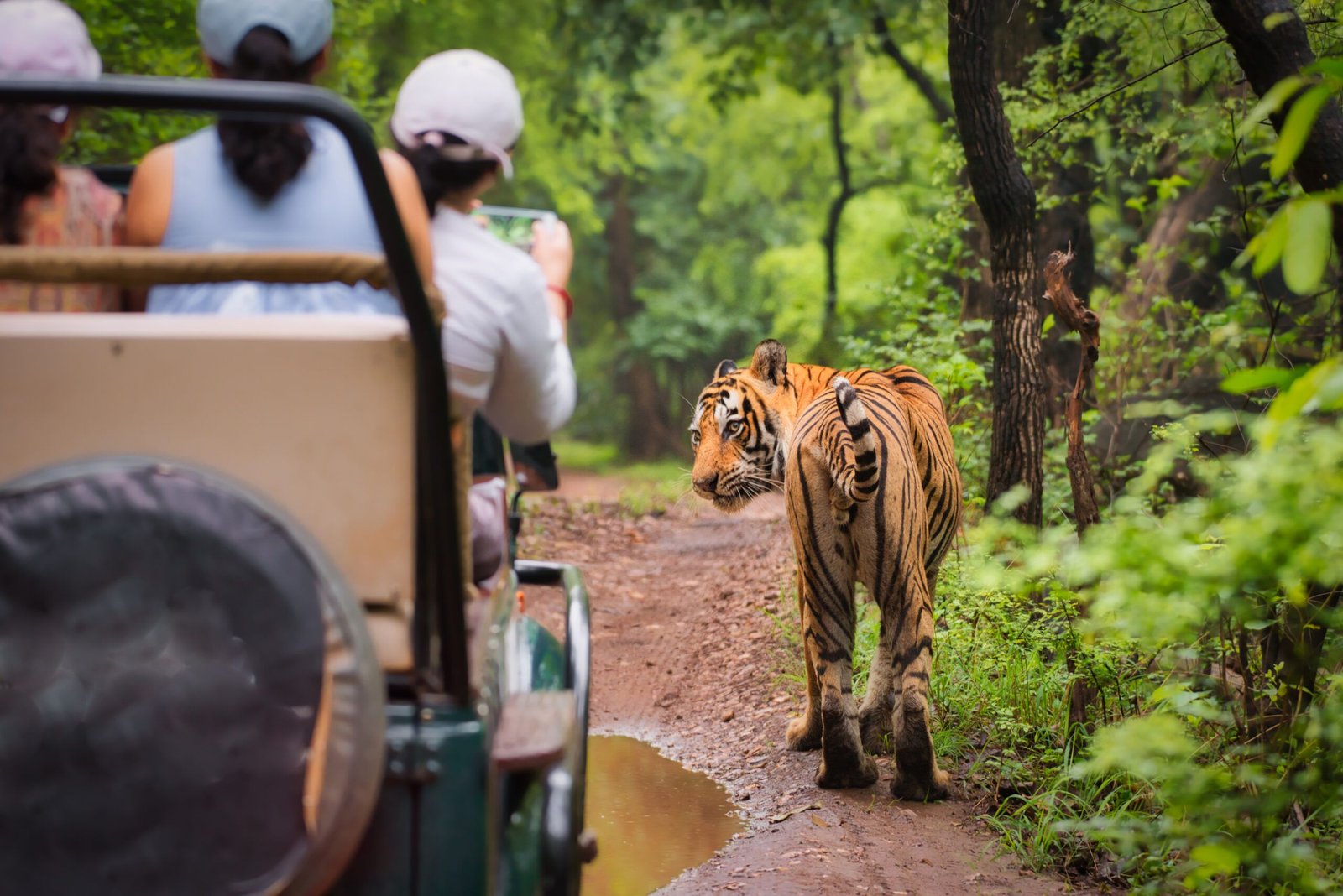India’s wilderness beckons with the promise of adventure, but smart travelers know that the most meaningful journeys leave the lightest footprint. As conservation awareness grows and responsible tourism takes center stage, eco-friendly wildlife safaris in India offer nature enthusiasts the chance to witness magnificent creatures while actively contributing to their protection.
From the mangrove forests of Sundarbans to the grasslands of Kanha, India’s national parks are embracing sustainable practices that ensure future generations can experience the same wonder we feel when spotting a tiger through morning mist or hearing the call of a peacock at dawn. This guide explores how you can embark on transformative wildlife safaris in India that benefit both you and the ecosystems you visit.

The Rise of Responsible Wildlife Tourism
Conservation-minded travelers are reshaping how we experience India’s wild spaces. Traditional safari models focused primarily on animal sightings, but today’s eco-conscious approaches prioritize habitat preservation, community involvement, and sustainable practices.
Modern wildlife safaris in India now incorporate educational elements about conservation challenges, support local communities through employment and fair trade partnerships, and use low-impact transportation methods. This shift reflects growing awareness that tourism can be a powerful force for positive change when managed thoughtfully.
The numbers support this trend. Parks that implement sustainable tourism practices report higher visitor satisfaction rates, improved wildlife populations, and stronger local economies. Travelers increasingly seek experiences that align with their values, making responsible safari operators the preferred choice for conscious adventurers.
Corbett National Park: Pioneer of Sustainable Safari Practices
As India’s first national park, established in 1936, Corbett National Park has evolved into a model for responsible wildlife tourism. The park’s commitment to conservation extends beyond protecting its famous Royal Bengal tigers to encompass comprehensive ecosystem management.
Corbett’s eco-friendly initiatives include electric vehicle safaris in certain zones, limiting daily visitor numbers to reduce stress on wildlife, and partnering with local communities for sustainable accommodation options. The park’s buffer zones support village-based tourism, where visitors can experience rural life while contributing directly to local economies.
The best time to visit Corbett spans from November through June, with each season offering unique wildlife experiences. Spring months provide excellent tiger sightings, while winter brings migratory birds and comfortable temperatures for extended nature walks.
Responsible visitors can enhance their impact by choosing eco-certified lodges, following strict wildlife viewing guidelines, and participating in conservation education programs offered by park authorities.
Ranthambore: Where Tigers and Conservation Coexist
Ranthambore National Park demonstrates how wildlife safaris in India can successfully balance tourism with conservation. The park’s tiger population has steadily increased thanks to anti-poaching efforts funded partly by tourism revenue and community-based conservation programs.
Eco-friendly safari options in Ranthambore include smaller group sizes, trained naturalist guides who emphasize conservation education, and partnerships with local artisan communities. Visitors can explore the park’s diverse ecosystem, spotting jackals, leopards, and various deer species while learning about habitat restoration efforts.
The park’s October through June season offers different conservation stories. Early winter showcases successful breeding programs, while summer months demonstrate water conservation strategies that benefit both wildlife and surrounding communities.
Sustainable accommodations near Ranthambore often feature solar power, water recycling systems, and locally sourced organic food, allowing visitors to minimize their environmental impact while supporting regional economies.
Gir National Park: Saving the Asiatic Lion Through Community Partnership
Gujarat’s Gir National Park offers one of India’s most successful conservation stories. The park’s Asiatic lion population has recovered from near extinction through collaborative efforts between park management, local communities, and responsible tourism operators.
Gir’s eco-friendly safari model includes extensive community involvement, with local guides sharing traditional knowledge about wildlife behavior and habitat management. The park’s sustainable tourism practices support surrounding villages through employment opportunities and fair trade craft sales.
The December through March visiting season aligns with the park’s conservation calendar, when researchers conduct population surveys and habitat assessment studies that visitors can learn about during their stay.
Wildlife enthusiasts can participate in citizen science programs, contribute to conservation research through photo documentation, and support community-based conservation initiatives that protect both lions and their prey species.
Kanha: Community-Driven Conservation Success
Kanha National Park exemplifies how wildlife safaris in India can drive meaningful conservation outcomes. The park’s successful Barasingha (swamp deer) recovery program demonstrates the power of combining scientific management with community support and sustainable tourism.
Kanha’s eco-friendly approach includes extensive collaboration with surrounding tribal communities, who serve as forest guards, guides, and conservation educators. The park’s sustainable tourism model ensures that local communities benefit directly from wildlife protection efforts.
Mid-October through June offers optimal wildlife viewing while supporting the park’s conservation research programs. Visitors can observe ongoing habitat restoration projects, learn about successful breeding programs, and understand how tourism revenue funds anti-poaching activities.
The park’s commitment to education extends to visitor programs that highlight the interconnection between healthy ecosystems, wildlife conservation, and sustainable tourism practices.
Bandhavgarh: High-Density Tiger Conservation
Bandhavgarh National Park’s reputation for exceptional tiger sightings comes with a strong commitment to sustainable tourism practices. The park’s high tiger density results from successful conservation programs supported by responsible tourism revenue.
Eco-friendly safari experiences in Bandhavgarh emphasize small group sizes, expert naturalist guides, and comprehensive conservation education. Visitors learn about the park’s 2,000-year history while understanding modern conservation challenges and solutions.
The October through June season provides opportunities to witness various conservation activities, from camera trap monitoring to habitat management practices that maintain healthy tiger populations.
Sustainable accommodations around Bandhavgarh often feature wildlife-friendly designs, renewable energy systems, and partnerships with local conservation organizations, allowing visitors to extend their positive impact beyond park boundaries.
Pench: Inspiration for Sustainable Wildlife Tourism
Pench National Park, famous as the inspiration for Kipling’s “The Jungle Book,” demonstrates how wildlife safaris in India can honor literary heritage while promoting conservation. The park’s sustainable tourism model includes extensive environmental education programs and community-based conservation initiatives.
Pench’s eco-friendly practices include habitat restoration projects that visitors can observe, research programs studying human-wildlife conflict resolution, and community partnerships that provide alternative livelihoods for local residents.
The February through April visiting season offers optimal wildlife viewing while supporting the park’s conservation research calendar. Visitors can participate in bird monitoring programs, learn about endangered vulture conservation efforts, and understand ecosystem restoration techniques.
The park’s commitment to sustainability extends to visitor facilities, with eco-certified lodges and low-impact transportation options that minimize environmental disruption while maximizing wildlife viewing opportunities.
Sundarbans: Mangrove Conservation and Coastal Protection
The Sundarbans Wildlife Sanctuary represents a unique model for marine ecosystem conservation through sustainable tourism. This UNESCO World Heritage Site demonstrates how wildlife safaris in India can protect critical habitats while supporting coastal communities.
Sundarbans’ eco-friendly safari options include boat tours with local guides, educational programs about mangrove ecosystem services, and community-based tourism initiatives that provide alternative livelihoods for traditional fishing communities.
The September through March season offers optimal wildlife viewing while supporting the park’s conservation research programs. Visitors can learn about climate change adaptation strategies, observe mangrove restoration projects, and understand how sustainable tourism helps protect this critical ecosystem.
The park’s unique challenges, including sea-level rise and coastal erosion, make it an important case study for climate-resilient conservation strategies supported by responsible tourism revenue.
Choosing Responsible Safari Operators
Selecting eco-friendly safari operators enhances your conservation impact while ensuring memorable wildlife experiences. Look for operators who employ local guides, support community-based conservation projects, and follow sustainable transportation practices.
Responsible operators typically offer smaller group sizes, comprehensive conservation education, and transparent information about their environmental and social impact. They often partner with certified eco-lodges and contribute directly to conservation research and anti-poaching efforts.
Many eco-friendly safari operators provide pre-visit educational materials, helping travelers understand conservation challenges and how their visit contributes to solutions. This preparation enhances the safari experience while maximizing positive impact.
Sustainable Accommodation Options
Eco-certified lodges near India’s national parks offer comfortable stays while minimizing environmental impact. These facilities typically feature renewable energy systems, water conservation programs, and locally sourced organic food options.
Many sustainable accommodations employ local staff, support community development projects, and offer cultural experiences that complement wildlife viewing. These partnerships ensure tourism benefits extend beyond park boundaries to surrounding communities.
Choosing eco-friendly accommodation often provides enhanced wildlife experiences, as these facilities typically maintain wildlife-friendly grounds, offer expert naturalist guides, and provide comprehensive conservation education programs.
Maximizing Your Conservation Impact
Responsible safari participants can amplify their conservation impact through various actions. Following strict wildlife viewing guidelines, respecting animal behavior, and supporting local conservation initiatives all contribute to positive outcomes.
Many parks offer volunteer opportunities, from habitat restoration projects to research assistance programs. These experiences provide deeper understanding of conservation challenges while offering hands-on contribution opportunities.
Documenting your wildlife sightings through photography and wildlife apps can contribute to scientific research. Many parks use visitor data to track animal populations, monitor habitat health, and assess conservation program effectiveness.
The Future of Eco-Friendly Wildlife Tourism
India’s commitment to sustainable wildlife tourism continues expanding, with new initiatives focusing on climate resilience, community empowerment, and technology integration. These developments promise even more impactful conservation outcomes from responsible tourism.
Emerging technologies like camera traps, drone monitoring, and artificial intelligence are enhancing both wildlife protection and visitor experiences. These tools allow for less intrusive wildlife viewing while providing comprehensive conservation data.
Climate change adaptation strategies are becoming integral to sustainable safari operations, with parks developing resilient infrastructure and wildlife corridors that ensure long-term ecosystem health.
Supporting Conservation Through Conscious Travel
Wildlife safaris in India offer extraordinary opportunities to witness natural wonders while contributing to their protection. By choosing responsible operators, staying at eco-certified accommodations, and following sustainable practices, travelers become active participants in conservation success stories.
The transformation of India’s wildlife tourism sector demonstrates how conscious travel choices can drive positive change. Each responsible safari visit supports habitat protection, community development, and wildlife conservation efforts that ensure these magnificent ecosystems thrive for future generations.
Ready to embark on your eco-friendly Indian safari adventure? Research certified operators, choose sustainable accommodations, and prepare to experience the wild beauty of India while contributing to its conservation. Your journey awaits—one that promises not just incredible memories, but lasting positive impact on the natural world.






